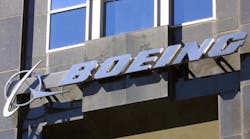Boeing Co. is turning to an outsider for the first time to head the commercial airplanes division, replacing Ray Conner with Kevin McAllister, a 27-year veteran of General Electric Co.’s aviation business.
McAllister, 53, the former chief executive officer of GE Aviation Services, assumed the leadership of Boeing’s largest business on Monday, according to a statement by the planemaker. Conner, 61, will stay on as vice chairman through 2017.
The company also promoted Stan Deal to the role of president and CEO of Boeing Global Services, creating a third division that combines customer-service groups within the commercial airplane and defense units. Boeing CEO Dennis Muilenburg sees the potential to build a $50 billion business by bolstering service offerings, from providing spare parts to conducting round-the-clock maintenance.
“We’ve always said that growing services was a key part of our strategy,” Muilenburg told reporters during a conference call Monday. The latest leadership changes underscore that “actions follow words,” he said.
Management Shifts
Muilenburg, who took over last year, has made a series of management shifts that place the company’s largest businesses under executives with backgrounds in services.
The latest move reshapes the manufacturer’s largest business with new leadership amid a turbulent market for commercial aircraft. The Chicago-based company announced Oct. 14 that Ihssane Mounir would replace the retiring John Wojick, a key Conner deputy, early next year as chief airplane salesman.
With McAllister, Boeing gains an executive with deep ties to airlines worldwide, including some who are exclusively Airbus Group SE customers, and a reputation for using data to analyze airlines’ wants and needs. He’d been viewed as a potential successor to David Joyce, who heads GE Aviation and is a vice chairman, said Rick Kennedy, a spokesman for GE.
McAllister has been GE’s “face” to all of its airline customers for 15 years, first leading the sales team and more recently as the head of the unit selling long-term service contracts and spare parts. The business is a major source of profit for GE, accumulating a backlog of services worth more than $120 billion, Kennedy said.
McAllister is a “very solid guy with a great background in aviation,” said Richard Aboulafia, an aerospace analyst at Teal Group in Fairfax, Virginia. “He’s a big customer and part of their biggest industrial partner company, too. That’s a unique combination.”
Aircraft Decisions
A materials engineer by training and University of Pittsburgh graduate, McAllister will be the first outsider to lead Boeing Commercial Airplanes since the unit was formed in 1965. The company selected McAllister after considering a mix of external and internal candidates to succeed Conner.
McAllister has worked closely with Boeing over the years, Muilenburg said. “I’m not sure I’d call him an outsider,” the CEO said. “He’s been very, very close to us for a couple of decades.”
While McAllister masters the nuances of Boeing’s culture and works to earn the respect of its factory workers and engineers, he also will face crucial product-strategy decisions. Perhaps the most critical is the call expected next year on Boeing’s first all-new airplane since the 787 Dreamliner: a new plane family aimed at the market gap between Boeing’s largest single-aisle and smallest twin-aisle jetliners.
Through his role at GE, McAllister “saw both the challenges and failures of the 787,” Howard Rubel, an aerospace analyst at Jefferies, said by phone. “So, he knows how hard it is to run an airplane company. He saw how hard it was to launch a new engine.”
McAllister also will be under pressure to bolster margins as the planemaker slows production of the 777, its second-largest source of profit. He may also have to navigate potential fall-out from the economic penalties President-elect Donald Trump has threatened to impose on China, Boeing’s largest overseas market.
Conner Exit
Conner has served as corporate vice chairman since 2013, and president and CEO of commercial airplanes since 2012. A 39-year Boeing veteran, he led the division during an era of historic jetliner sales, then warned workers that tougher times and cost reductions lay ahead. During his watch, record output at Boeing’s factories boosted the segment’s revenue to $66 billion, up 34 percent from 2012.
He is a throwback, known for close ties forged with customers as the planemaker’s former sales chief. A native of Burien, Washington, a working-class suburb south of Seattle, Conner joined his father and brother at Boeing in 1977, landing a job as a mechanic building 727 jetliners.
Conner will help smooth the transition to a new generation of leaders, Muilenburg said, while helping Deal knit together the government and commercial services businesses. Conner will also stay “engaged in our product development activities, including the production transformation under way,” Muilenburg said.
Services Unit
Deal, 52, who was rumored to be an heir to Conner, had served as senior vice-president of Boeing’s Commercial Aviation Services business since 2014. His new business will have about 20,000 employees and will maintain a headquarters staff of a “couple dozen” in Dallas.
The lines between Deal’s new unit and Boeing airplane and defense divisions will be blurry in places, with some customer-facing groups staying in place inside the current business units.
Deal’s current operation has more than 12,000 employees and provides airlines and leasing companies with wide ranging support services, from maintenance training to digital crew scheduling. Another 13,000 employees support military and government customers worldwide.



